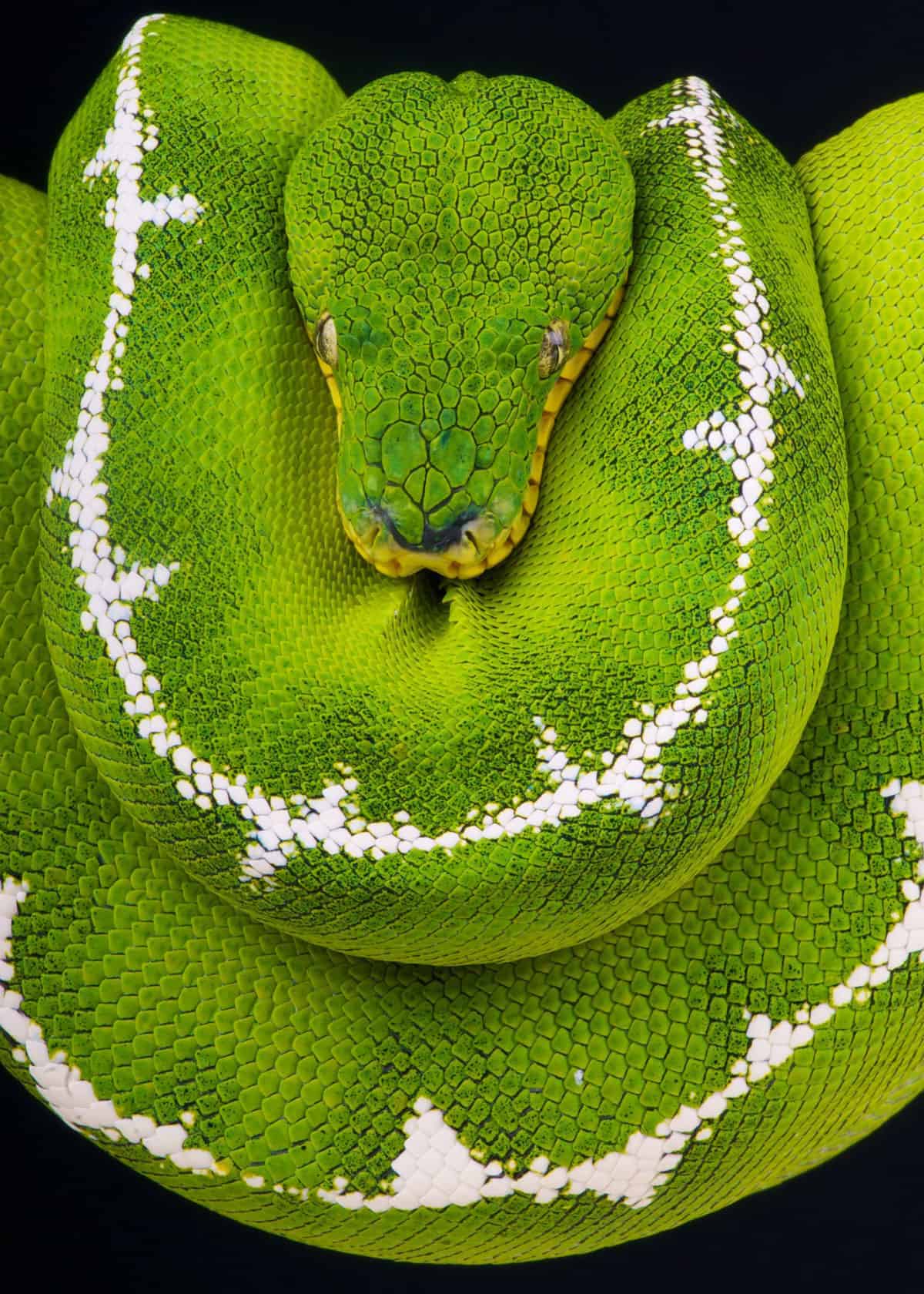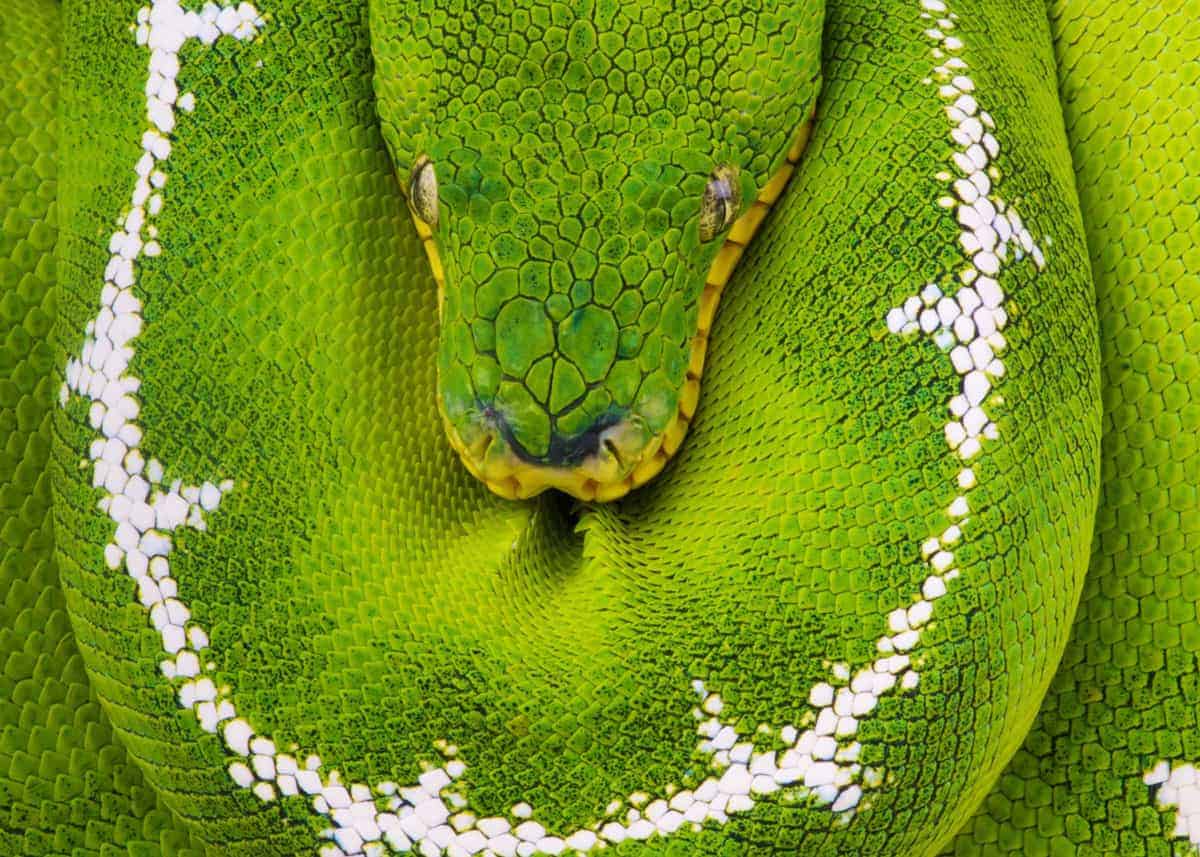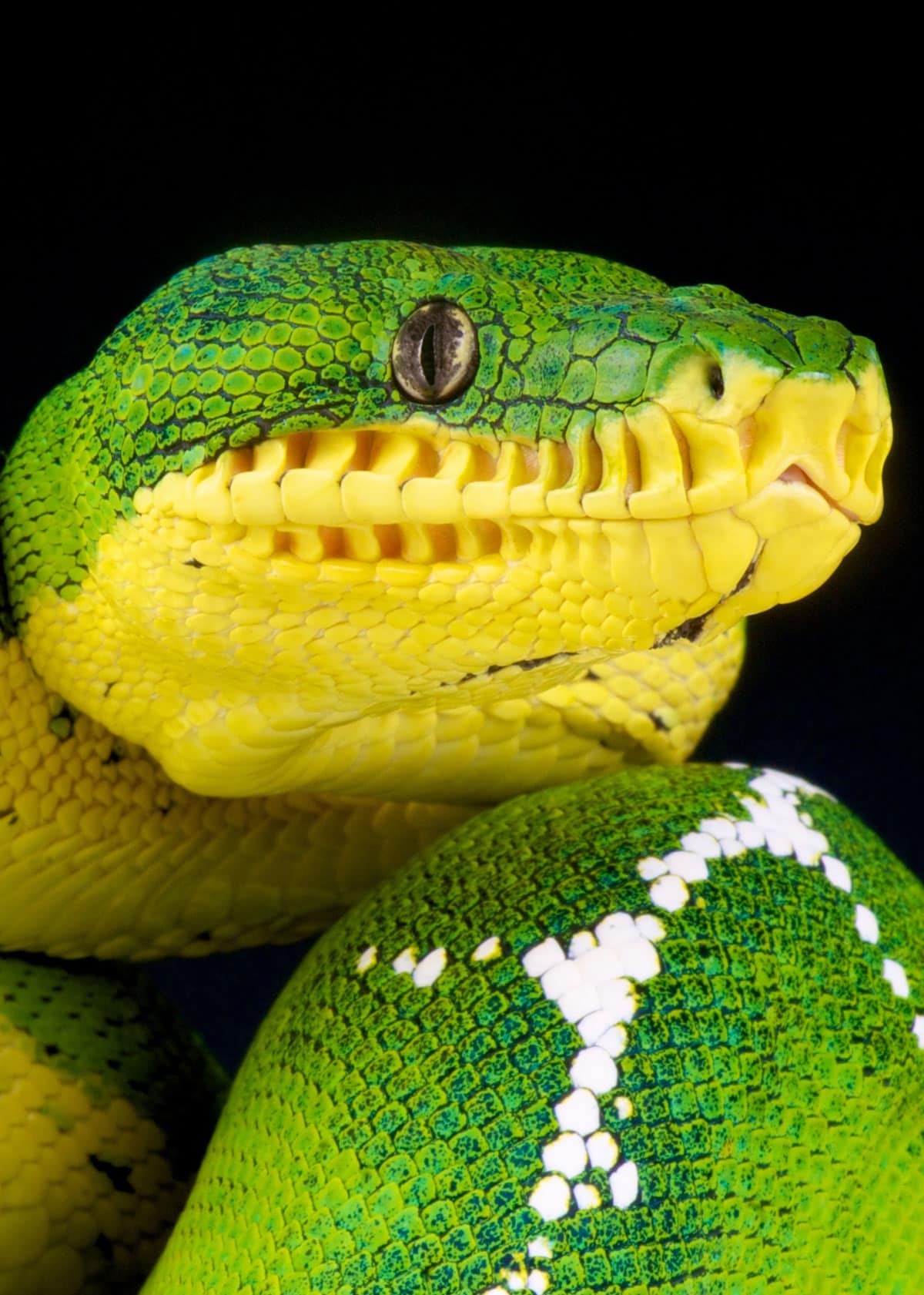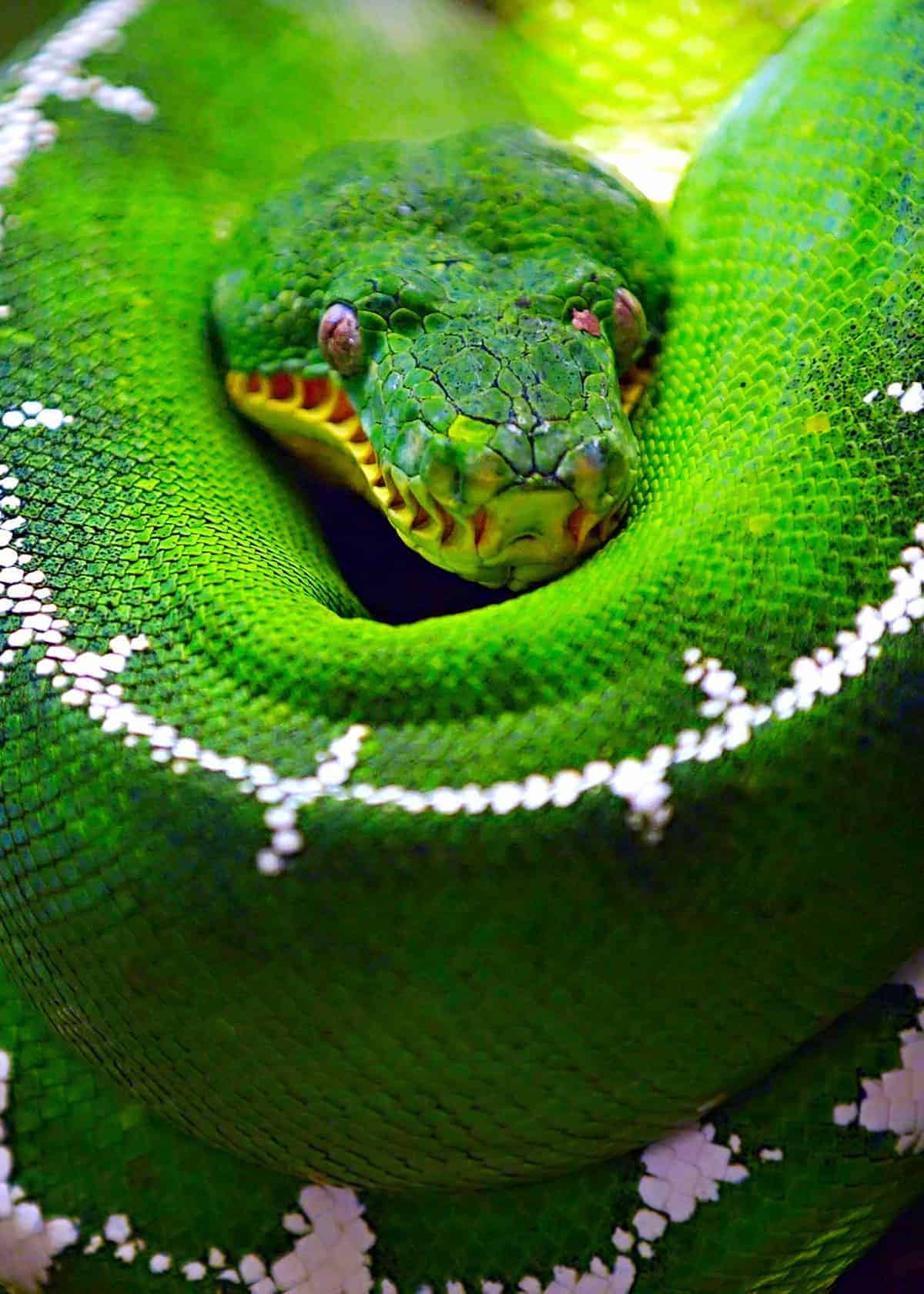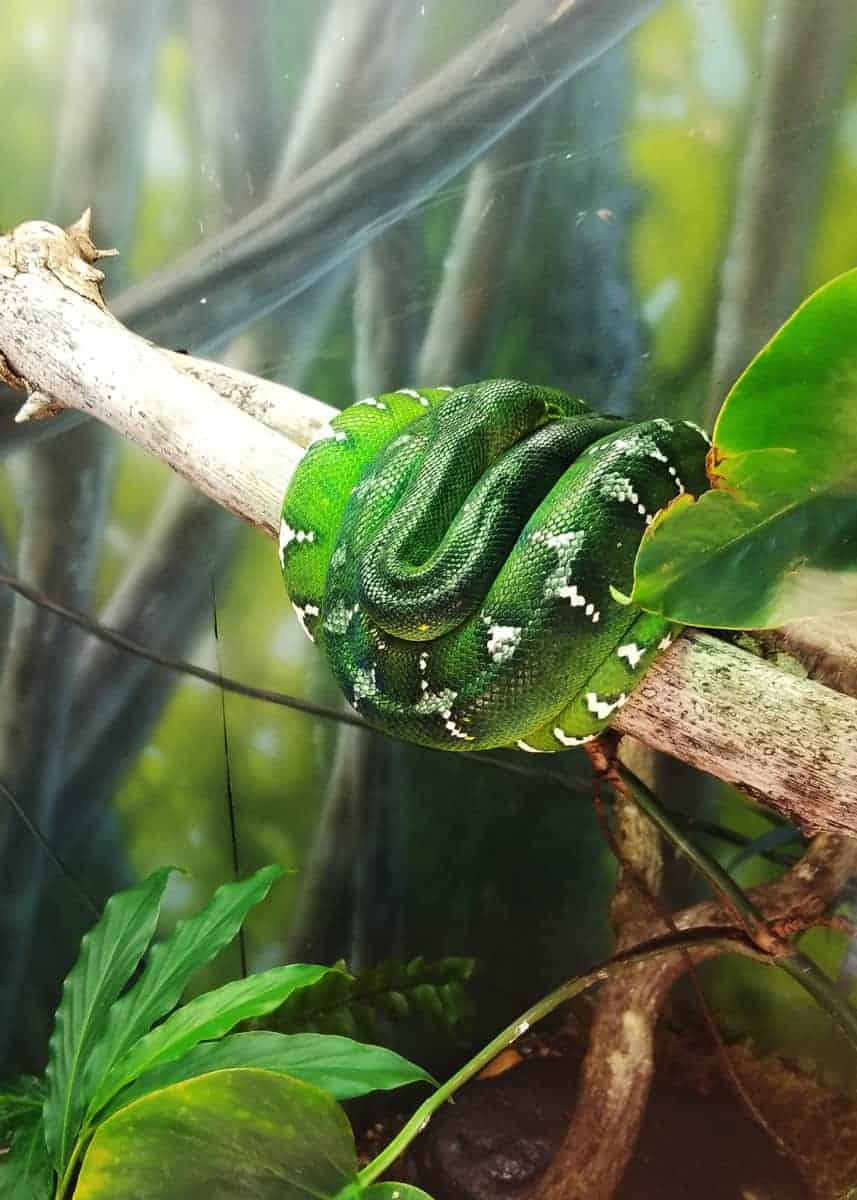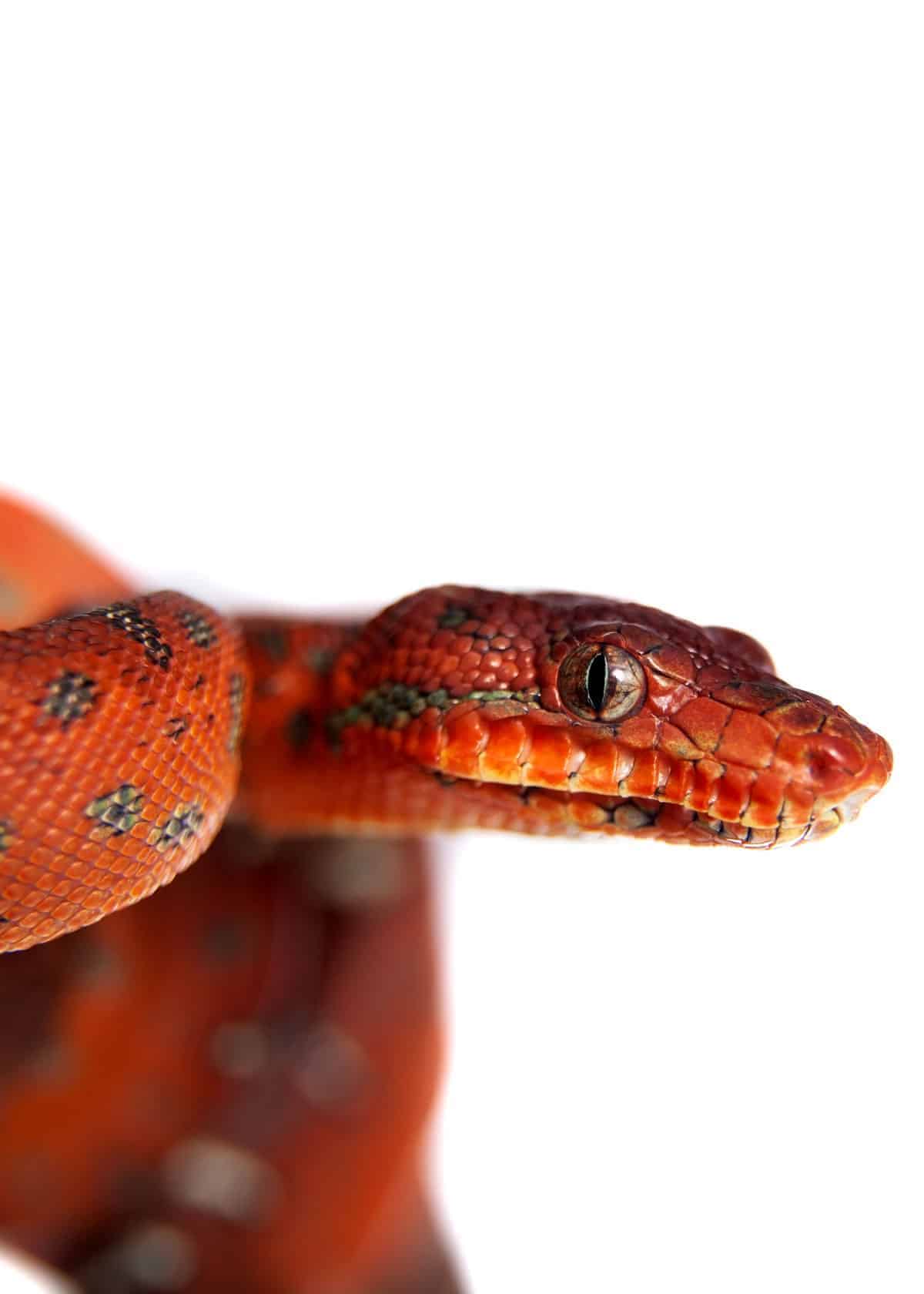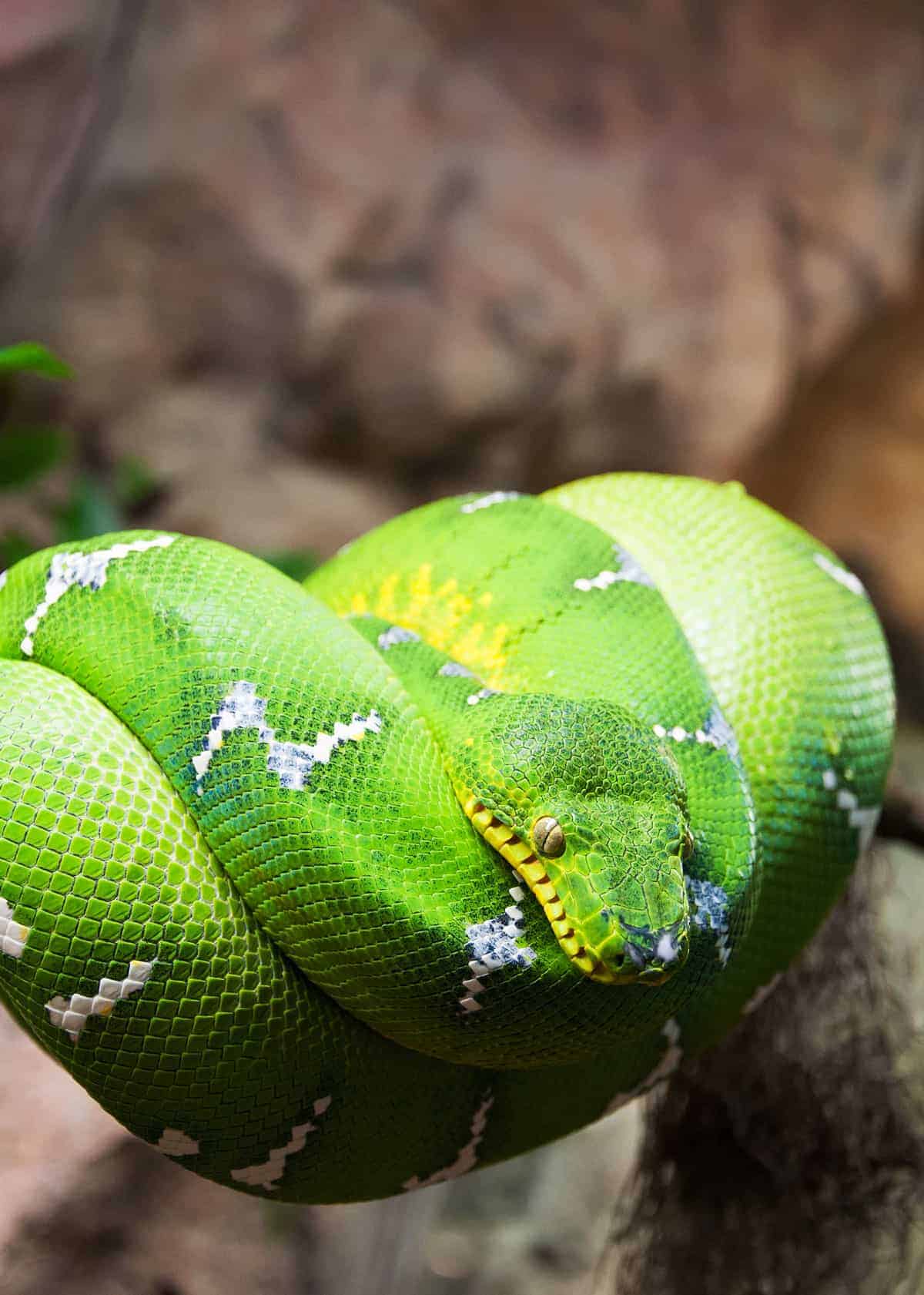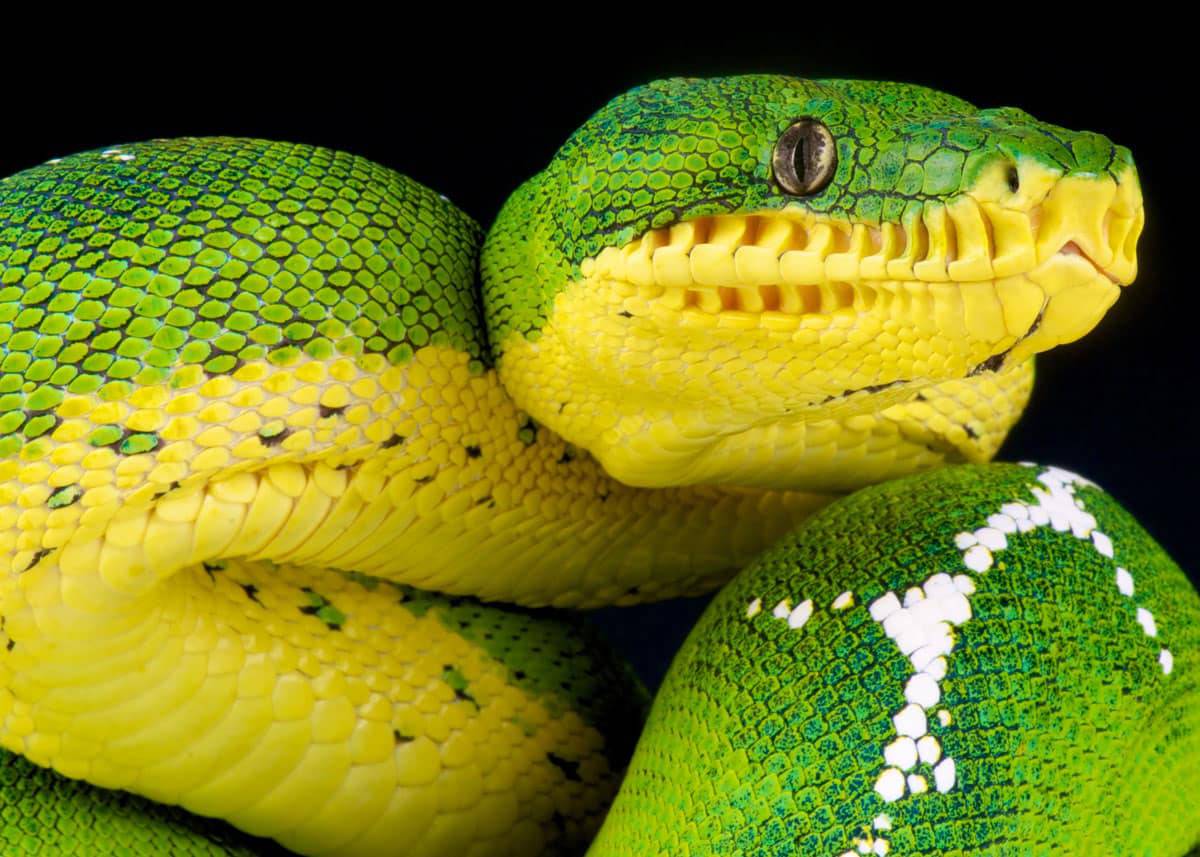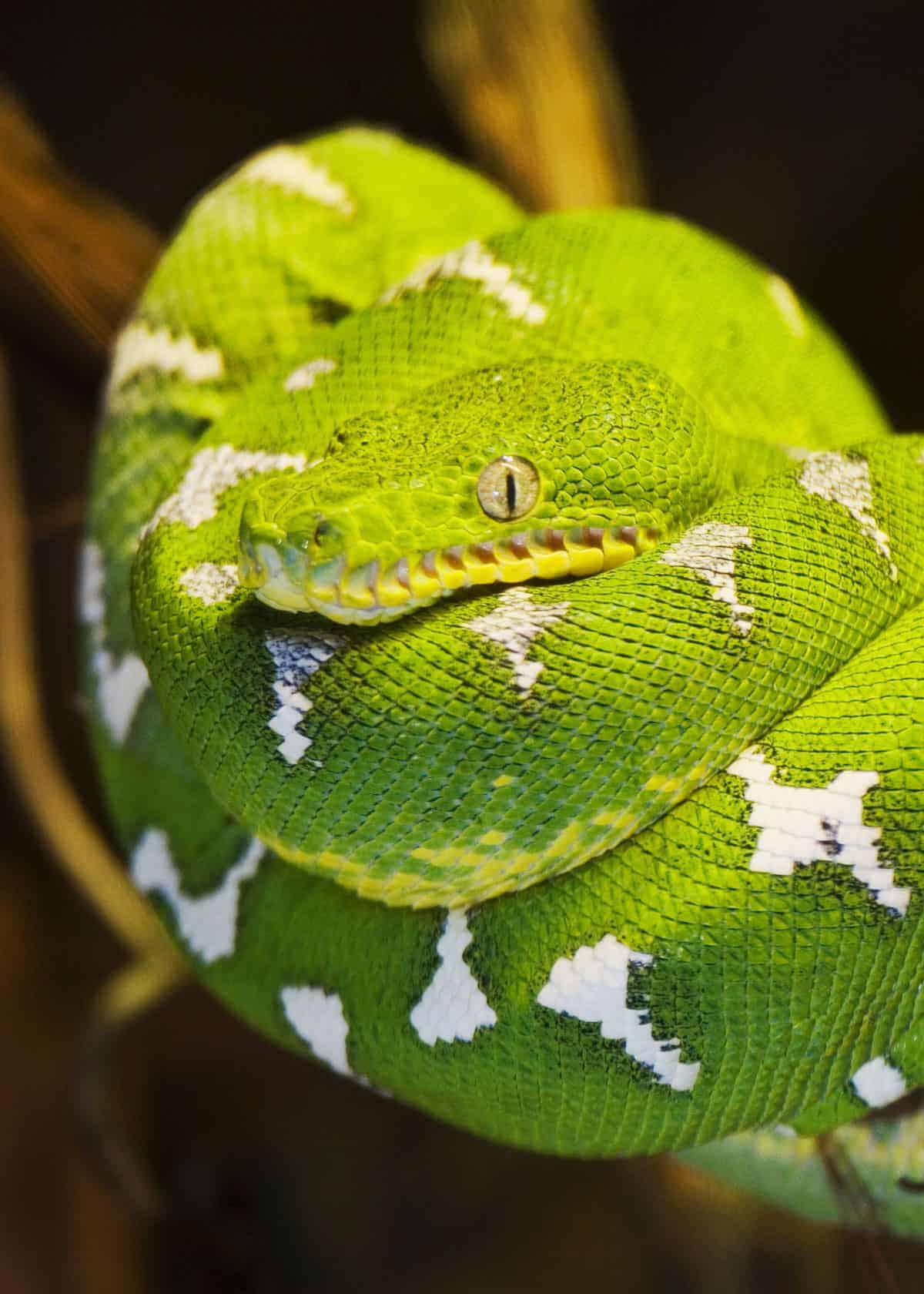45 Emerald Tree Boa Facts (Guide to Both Species) Diet, Habitat, Babies, Photos, Pets
Interested in the emerald tree boa? In this post, you’ll learn 45 emerald tree boa facts – about both species. Including their diet, range, giving birth (yes – with a video!), and much more. Plus lots of photos.
Safety tip: While emerald tree boas aren’t usually aggressive to humans (more below), it’s a good idea to keep a safe distance. If you’re traveling to the Amazon basin, you should bring a camera with a good zoom and a decent pair of binoculars. These will increase the odds of spotting and shooting an emerald tree boa in the wild
45 Emerald Tree Boa Facts
With bright eyes, patterned scales and jewel-like colors, the emerald tree boa is one of the most gorgeous snakes in South America. But there’s a lot more to this species than what meets the eye!
Here are just a few emerald tree boa facts that range from the hilarious to the horrifying.
Emerald Tree Boa Overview
- Latin name: Corallus caninus and corallus batesii (2 species)
- Range: South America (Brazil, Peru, Ecuador, Venezuela, Colombia, French Guiana, Suriname, Guyana, Bolivia)
- Population Status: Least concern
- Length: 4 – 9 feet
- Weight: 2 – 4 pounds
- Diet: Rodents, lizards, frogs, squirrels
- Physical features: Vivid green coloring, white “lightning bolt” scale patterns, extremely long front teeth
- Where it lives in Ecuador: Amazon basin (eastern Ecuador)

1. What is an emerald tree boa?
The emerald tree boa is a specific type of non-venomous snake that lives in the tree canopies of the Amazon rainforest.
However, you’ve probably seen them in zoos and exotic pet stores all around the world. They’re quite unique in terms of color, diet, habitat, and body structure, so they’re always a crowd-pleaser.
2. How many species of the emerald tree boa are there?
There are two populations of emerald tree boas living in South America; one resides in the Guiana Shield while another inhabits the Amazon Basin.
For a long time, scientists assumed that these populations were the same species living in separate regions. It took further research to realize that there were major differences between the two.
As a result, the Amazon basin snakes were reclassified as corallus batesii while the Guiana Shield snakes remained corallus caninus.
3. What does the emerald tree boa look like?
There are several ways that emerald tree boas stand out from other snakes in the Amazon.
For starters, they have astonishing colors. The most common is a bright emerald green that matches their name, but they can also be a light, yellowish-green or dark olive green. Their bellies are yellow.
Emerald tree boas are also known for the white “lightning bolts” that zig-zag along their back.
These markings stand out quite clearly against their green scales, so it’s easy to distinguish emeralds from other snakes that live in trees.
Finally, emerald tree boas have long, curved teeth that are much more prominent than other members of their genus.
These teeth don’t contain any venom, but they play a vital role in the emerald’s hunting.
4. Differences between Corallus caninus and corallus batesii
In 2009, the species Amazon Basin Emerald Tree Boa became its own species when it was “revalidated from the synonymy Corallus caninus by HENDERSON”. ~ Reptile Database.
- Emerald Tree Boa (Guiana Shield): (Corallus caninus) Emerald green color with white zigzag stripes (lightning bolts) along its back. Grows to about 6 feet (1.8 m) in length.
- Amazon Basin Emerald Tree Boa: (Corallus batesii) Most noticeable difference is the white vertebral stripe that runs the length of its body. There are intermittent white crossbars with some random black spots. Its back (dorsum) is dark green and has a yellow belly. Adults grow to about 9 feet (2.7 m) in length.
Notice the differences in the following images:
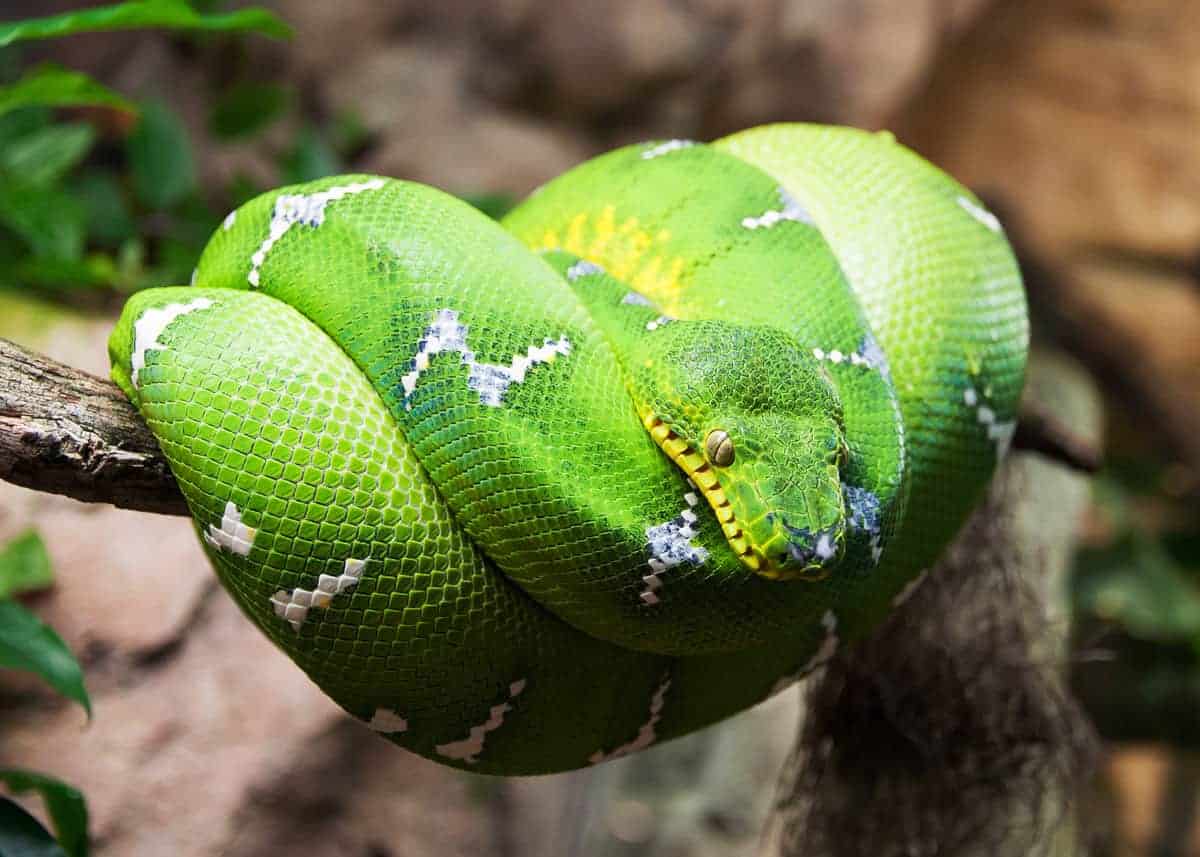
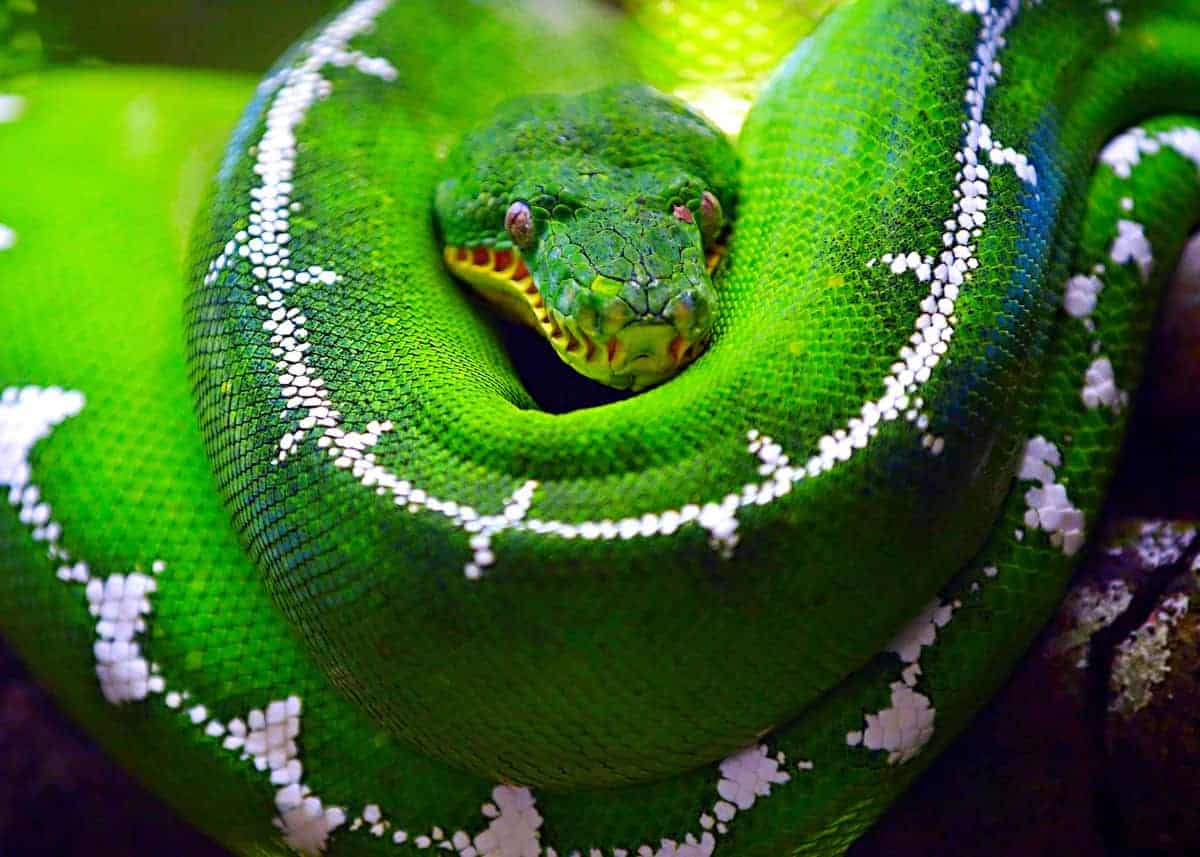
The species are genetically similar. Corallus caninus and corallus batesii can interbreed and their litters are fertile. Hybrids are visually distinct from both parents.
5. What emerald tree boa species lives in Ecuador?
Both species (Corallus caninus and corallus batesii) are found in Ecuador.
And while Corallus caninus (emerald tree boa) is identified with the Guiana Shield region (areas east of Ecuador), it does exist in Ecuador’s Amazon region.
6. How big is an emerald tree boa?
- Guiana Shield snakes are smaller and brighter than their cousins; they measure between 4 – 6 feet.
- Amazon Basin snakes are a longer at 7 – 9 feet.
7. How much does an emerald tree boa weigh?
Emerald tree boas usually weigh between 2 – 4 pounds.
In an interesting twist, females are bigger than males. They top the scale at 3 – 4 pounds while males are slightly lighter at 2 – 3 pounds.
8. How big do emerald tree boas get?
The largest emerald tree boa was said to be 10 feet long. However, this was an unconfirmed report, so take it with a grain of salt.
9. Do emerald tree boas actually live in trees?
Yes. With their natural green camouflage, emerald tree boas are most comfortable in the tree canopies of rainforests and wetlands. They slither through the leaves and coil around the branches with their entire bodies.
They even have long, prehensile tails that they use for gripping.
One funny feature of emerald tree boas is that they like to curl around tree branches with their heads resting on the middle of their bodies like a pillow. Only a few other snake species do this.
10. How did the emerald tree boa get its name?
The emerald tree boa has a pretty straightforward name. “Emerald” refers to its bright green coloring, and “tree boa” is a casual way to describe boa constrictors that are arboreal (tree-dwelling).
11. What is the emerald tree boas Latin name?
The scientific name of the first type of emerald tree boa is corallus batesii.
“Corallus” refers to its coral-like skin, and “batesii” is named in honor of the famous explorer and naturalist Henry Walter Bates.
The scientific name of the second emerald tree boa is corallus caninus. “Corallus” comes from its skin, and “caninus” means “like a dog.”
Why are dogs involved? When the famous zoologist Carlos Linnaeus discovered the emerald tree boa in 1758, he decided that its wide-set head and snout resembled man’s best friend.
It also had long, pointed teeth that were much bigger than other snakes, and those reminded him of a dog’s canines.
As for the official classification of the emerald tree boa, both types break down like this:
- Class: Reptilia (reptiles)
- Order: Squamata (lizards, snakes)
- Family: Serpentes (snakes)
- Subfamily: Boidae (a family of nonvenomous snakes)
- Genus: Corallus (a family of nonvenomous snakes found in South and Central America)
- Species: Corallus caninus and corallus batesii (the emerald tree boas)
12. Are emerald tree boas nocturnal?
Yes. Most of their hunting and exploring is done by night but emerald tree boas aren’t completely lifeless during the day. Their daytime activity is limited to finding a good spot for sunbathing and stretching out like a cat whenever one side gets too warm.
13. Do emerald tree boas have fangs?
Technically, emerald tree boas don’t have fangs. “Fangs” are only used to describe sharp, pointed teeth that are connected to venom glands and emerald tree boas are non-venomous.
When you look inside of their mouths, however, you might be hard-pressed to say that emerald tree boas don’t have fangs.
Their front teeth are large and razor sharp, and their pinkish gums really stand out against their green scales. Their teeth might not be classified as fangs, but they definitely make an impression!
14. Is the emerald tree boa poisonous?
No. Emerald tree boas aren’t poisonous and don’t have any venom glands.
Like other boa constrictors, they kill their victims by coiling around their bodies and slowly squeezing the life out of them.
15. Are emerald tree boas aggressive?
In the wild, emerald tree boas can be quite aggressive. They’re ambush predators that only have one strike to catch their prey off guard, so they move quickly and decisively.
Guiana Shield snakes are known for being rowdier than their Amazon Basin counterparts; no one is quite sure why, but it might have something to do with their bigger range and the number of predators there.
In captivity, however, emerald tree boas can be quite docile. They’re content to lay around and sun themselves on their warming rocks or under their heat lamps. When they act out, it’s usually because of illness or enclosure issues.
One notable exception to this lazy behavior is if you put two males in the same enclosure. Emerald tree boas can become quite hostile when they’re forced into close proximity like this, and the bigger male might chase, mount and even coil itself around the smaller one to prove his dominance.
16. Can an emerald tree boa kill a human?
There have been no documented human deaths due to emerald tree boas. They aren’t venomous, so their bite won’t kill you, and they’re generally small enough that their constriction is only dangerous to small mammals.
That said, they’re still snakes! They can bite, hiss, coil, and display aggressive behavior if they aren’t being properly handled.
17. How long do emerald tree boas live?
No one has studied the lifespan of emerald tree boas in the wild. In captivity, however, they generally live around 20 years.
18. What’s the difference between an emerald tree boa and a green tree python?
Since they’re both small green snakes with white patterns on their scales, it’s common for emerald tree boas and green tree pythons to be confused with one another.
When you look closer, however, there are a number of differences between them.
- Species: Emerald tree boas are boa constrictors; green tree pythons are pythons. They aren’t from the same species, genus or family.
- Habitat: Emerald tree boas are native to South America. Green tree pythons are found in Asia and Australia.
- Markings: Emerald tree boas have white horizontal zig-zags that look like lightning bolts. Green tree pythons have small white dots that connect in vertical lines going down their bodies.
- Snouts: Emerald tree boas have much more angular snouts than the roundish green tree pythons. If all else fails, ask yourself if the snout looks more like a rectangle or a circle.
19. What eats an emerald tree boa? Predators and Threats
The largest predator of the emerald tree boa are birds of prey, like the harpy and crested eagle.
These are large birds have a wingspan of 4 – 6 feet, so they’re a formidable enemy. They’ll hunt all kinds of snakes, including the emerald tree boa.
Emerald tree boas are at risk from predators when they’re young, defenseless hatchlings.
20. How do emerald tree boas protect themselves?
The greatest weapon of emerald tree boas is their camouflage. They can move through tree canopies without detection because of their green coloring, and they’re also quite agile thanks to their prehensile tails. When they hear a predator coming, they can blend into their surroundings in the blink of an eye.
Something else that helps emerald tree boas is their slow metabolism. They don’t have to eat or defecate as much as other snakes, so they don’t leave obvious scent trails.
They can go months without doing their business, and they usually wait for a rainy day so that the water will wash away all traces of their feces.
If predators can’t find them, predators can’t eat them.
21. Is the emerald tree boa endangered?
No. According to the International Union for the Conservation of Nature (IUCN), emerald tree boas are considered “least concern” on the extinction scale.
While their exact population size is unknown, it’s estimated that there’s one emerald tree boa per square mile in the Amazon.
22. What are some of the dangers faced by emerald tree boas?
Emerald tree boas have such a large range and diverse diet that they won’t be endangered anytime soon.
However, there are a few things that are hurting their numbers in the wild:
- Habitat loss. This is an issue that’s affecting a lot of wildlife in South America. Whenever people build roads, houses, dams, mills, farms, and other hallmarks of civilization, they cut down the trees that animals depend on to survive. It’s a particular problem for the Amazon rainforest: Deforestation has reduced it by 18 percent in the last few decades alone.
- The pet trade. Emerald tree boas are often captured in the wild to be sold as pets. These snakes aren’t as docile as the ones that have been bred and raised in captivity, so it’s difficult, dangerous work, and it can result in the deaths of a lot of innocent emeralds.
- Hunting. Many snake species have cultural value in South America. Since emerald tree boas are bright and beautiful, they’re hunted for prizes or killed for fashion or local medicines.
23. What do emerald tree boas eat?
Emerald tree boas are carnivores. They like frogs, lizards, rodents, squirrels, pygmy marmosets, squirrel monkeys, and other small mammals and reptiles.
Researchers used to think that emerald tree boas preyed on birds, but after studies were done on their stomach content, bird remains weren’t found in their digestive tracts. It’s still possible that they go after birds, especially since they spend most of their time in trees, but it hasn’t been proven.
24. How do emerald tree boas hunt?
As nocturnal animals, emerald tree boas do most of their hunting at night. They’re ambush predators that like to slither in the shadows until it’s time to make a move.
Their green color helps with their disguise; they’re all but invisible when they blend into the leaves and branches of their favorite tropical trees. Between their natural camouflage and the darkness of the night, only the keenest of prey can see them coming.
As for their hunting techniques, they mostly hang from the lower branches of trees until a mouse or lizard crosses their path. Then, with their jaws wide open, they’ll strike at a downwards angle and grab their unsuspecting prey.
Contrary to popular belief, emerald tree boas don’t use their teeth to kill. They’re boas, and boas always constrict their prey and cause death through asphyxiation. Their teeth are only for striking, stunning, and snatching.
25. How do emerald snake boas detect their prey?
Emerald snake boas don’t rely on sight. While their slit-eye pupils have adapted to their nighttime hunting environments, their vision just isn’t that strong to begin with, so they can’t depend on it.
Instead, emerald tree boas make use of thermal receptor pits around their mouths. These are basically infrared sensors that allow them to detect the body heat of nearby prey. Many boa constrictors have them, but emerald tree boas possess a much larger number than other breeds, so they’re better hunters on the whole.
26. How often does an emerald tree boa hunt?
Emerald tree boas have extremely slow metabolisms, so they don’t have to hunt as often as other snakes. They can go months without eating before they need to descend from the trees and find something tasty.
27. Do emerald tree boas lay eggs?
This is a surprisingly complex question. The answer is Yes. And no.
Emerald tree boas are ovoviviparous, meaning that females develop and hatch eggs inside of their bodies before giving birth to live young. It’s basically a cross between the two main forms of reproduction in the animal kingdom. They aren’t alone – other snake species reproduce in the same way – like the poisonous bothrops asper.
Technically speaking, emerald tree boas don’t lay eggs. They don’t make nests. They don’t take care of their young after they’re born. They’re an incredibly unique species of snake!
Here’s a video of an emerald tree boa giving birth in captivity. Please remember, this is an animal giving birth. It gets a little messy. If you are squeamish, this might not be for you.
28. At what age do emerald tree boa reproduce?
Males reach sexual maturity around 3 – 4 years old. Females develop a bit slower and reach maturity at 4 – 5 years old. They start reproducing around these ages.
29. Do emerald tree boas have any courtship rituals?
There isn’t a ton of information on the mating habits of emerald tree boas, so everything should be taken as a best guess rather than a hard fact.
That said, most mating pairs form around late winter and early spring.
The pairs aren’t monogamous and won’t last beyond the one reproductive cycle unless the snakes are in captivity together with no other options. The male will coil next to the female and try to entwine his tail with hers; she might or might not reject him. If she does, things can get quite testy between them.
30. How often do emerald tree boas lay eggs?
Females tend to breed once every other year.
Since their gestation period is only 5 – 7 months, and since they don’t tend to their young after birth, no one knows why it takes them so long to be in a reproductive mood again.
It might have to do with the fact that expectant mothers fast during many months of their pregnancy; it might take their bodies some time to recover in between litters.
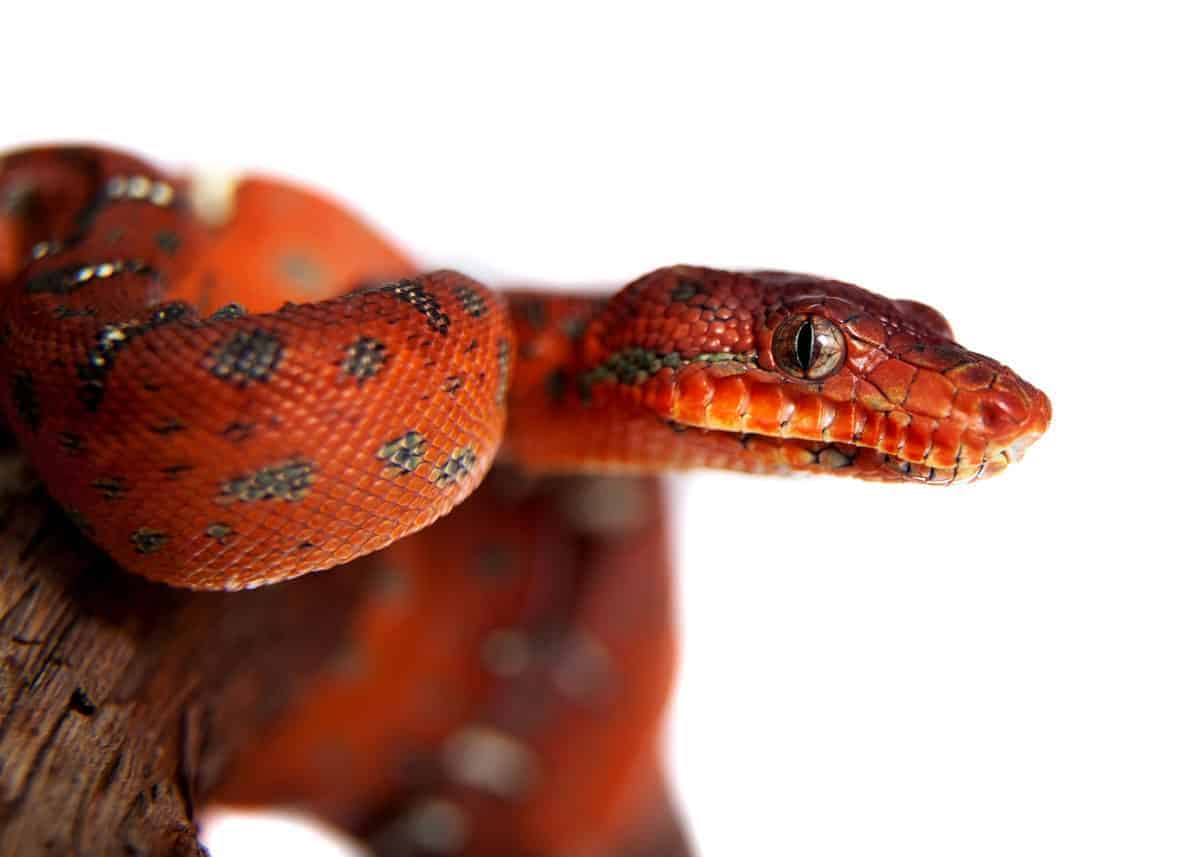
31. How many eggs does the emerald tree boa lay?
When it comes to actual hatchlings, emerald tree boas usually give birth to 5 – 12 babies at a time. Some litters can reach 20 babies or more, but this is rare.
It’s impossible to know how many eggs develop inside of an emerald tree boa since they hatch before they’re birthed. Females usually push out a certain amount of “sludge” along with their babies; this can include unfertilized eggs, underdeveloped embryos, and the remains of hatchlings that didn’t survive gestation.
It can be a gruesome sight, but it’s a reality for many ovoviviparous species!
Have you heard of snake-milking? This might make you wonder: Do snakes nurse their young?
32. What are young emerald tree boas like?
Hatchlings are independent from the moment of birth. Mom and dad don’t provide any care at all. The kids don’t need to eat until after they’ve shed for the first time, so they have a week or two to teach themselves how to wiggle, climb and hunt before they venture into the world.
An interesting fact about these juveniles is that they don’t have the vivid green color that defines their species.
Emerald tree boas are red, brown and orange when they’re born, and they only lighten over time. They don’t reach full greenness until they’re around 12 months old.
33. What sounds do emerald tree boas make?
Emerald tree boas aren’t known for being vocal.
In fact, many first-time owners worry about the fact that their snakes are so quiet. This is a good thing, however; a silent emerald is a content emerald.
They only hiss when they’re feeling ill, angry, threatened, or territorial.
34. Do emerald tree boas live in groups?
No. Emerald tree boas are solitary creatures that like to live alone.
They only interact with others of their kind when it’s mating season, and even then, male-female pairs only perform their reproductive duties before parting again. They don’t stick together to raise their young.
35. Do emerald tree boas carry disease?
Emerald tree boas can carry blood parasites and intestinal worms. They aren’t usually dangerous to humans, but they can be passed down from mothers to hatchlings, so you should arrange a trip to the vet before you start breeding your snake.
A slightly more alarming parasite found in emerald tree boas is something called cryptosporidium. It can cause cryptosporidiosis, a disease characterized by nausea, vomiting, diarrhea, fever and stomach cramps.
While not fatal on its own, it can lead to a weakened immune system that puts people at risk for other illnesses. It’s most common in emerald tree boas that were captured in the wild.
36. How do emerald tree boas regulate their body temperature?
As cold-blooded animals, emerald tree boas take on the temperature of the surrounding environment. They can’t generate their own heat like warm-blooded animals do.
So how do they regulate their body temperature? Their biggest defense against the weather is the canopy of their forest. When the sun is blazing, they can move to the cool shade of denser branches; when it gets a little chilly for their taste, they can move to branches with more sun exposure.
They also like to sunbathe. They’ll uncurl their bodies to maximize the amount of warm sunshine falling on their scales, and they’ll stay motionless in the sun to soak up the rays.
37. Where does the emerald tree boa live?
The emerald tree boa lives in two regions of South America:
- Emerald Tree Boa: The first, corallus caninus, lives in the Guiana Shield that consists of Guyana, French Guiana, Suriname, Colombia, Brazil and Venezuela. It’s the leaner and meaner snake. Despite the regional name (Guiana Shield), this species is also found in Ecuador’s eastern Amazon region.
- Amazon Basin Emerald Tree Boa: The second, corallus batesii, lives in the Amazon basin that includes Ecuador, Bolivia, Brazil, Colombia, Peru, and Suriname. It’s the more docile species, but it’s also rarer, so if you see one (even in captivity) it’s something to get excited about.
38. What is the habitat of the emerald tree boa?
They wouldn’t be emerald tree boas if they didn’t live in trees! Emeralds spend most of their time slithering through the branches of dense tropical rainforests and wetlands. They might descend to the ground to feed or sunbathe, but they’re far more comfortable in foliage.
A unique characteristic of emerald tree boas is that they aren’t as dependent on water sources (rivers, lakes…) like many other reptiles. This might be because they live in places that get a lot of rain; it’s rare to find emerald tree boas in climates without at least 50 – 60 inches of rain per year.
Their slow metabolisms might play a role as well; they might be able to sustain themselves on less water than other species.
It’s also possible that they get their water from leaves and tree bark as opposed to drinking straight from a river.
In captivity, emerald tree boas have been known to lick rocks, cage walls, and even their own scales to stay hydrated.
39. What layer of the rainforest does the emerald tree boa live in?
Emerald tree boas are mobile creatures that can be found in every layer of the Amazon rainforest. Most of them will stick close to the ground so that they can hunt the little mammals that scurry by.
Some emerald tree boa populations have been recorded at elevations as high as 3,200 feet.
41. How do emerald tree boas benefit their environments?
Emerald tree boas are a natural source of pest control.
They kill rats, bats, squirrels, possums, and lizards. Some villages in South America will even introduce emerald tree boas to their region so that the snakes will keep the rodent population down.
42. Where can I see the emerald tree boa?
Emerald tree boas are popular additions to animal and wildlife exhibits.
Whether it’s the San Diego Zoo, the Dallas World Aquarium or the North Carolina Museum of Natural Sciences, you can find emerald tree boas just about anywhere that people collect exotic animals. It’s simply a matter of finding somewhere close to you and reserving your ticket!
Or you could book your trip to South America and take a tour.
Emerald Tree Boa: Pet Facts
In this section, we’ll answer some common questions about keeping emerald tree boas as pets.
43. Is an emerald tree boa a good pet?
It depends on your definition of “good.”
In many countries, it’s legal to buy and sell emerald tree boas. But you’ll need to do your shopping from a pet store that specializes in exotic animals, and it won’t be cheap. The price of an emerald tree boa ranges from $300 – $600.
You’ll also need to take certain precautions with your new companion. An emerald tree boa needs a humid, temperature-controlled habitat that mimics a real rainforest, and that means setting up a special enclosure with everything from heat sensors to ventilation shafts.
It also means paying attention to the thermostat. You might need to adjust it every day or even multiple times per day to keep your snake happy. If you’re trying to breed a pair of emeralds, you’ll need to adhere to a very specific temperature range.
As for the humidity, Reptile Magazine recommends misting a special moisture pad every morning so that the water will slowly evaporate over the course of the day.
You can also purchase an automated misting system to do this task for you, but you’ll need to keep an eye on your snake to make sure that it’s never too wet or not wet enough.
Long story short, the emerald tree boa isn’t an easy snake to care for, but it might be worth the trouble and expense if you’re really in love with the species.
44. Do emerald tree boas have attitude problems?
It depends on your definition of “attitude.”
Emerald tree boas aren’t cuddly creatures by nature, so if you want them to curl around your arm or shoulder while you show them off, it will take time and training until they’re used to your touch. They might bite you when they’re still learning. They can also be sensitive and temperamental about changes in their environment, so woe betide you if their enclosure is 70°F instead of 71°F.
On the other hand, emerald tree boas can be taught to be calm, friendly, docile, and sociable. It just depends on how much energy you can invest in them.
Again: These are snakes that need a lot of TLC.
45. How are captive-born emerald tree boas different from wild-born ones?
Captive emeralds are generally calmer and easier to handle than wild ones, especially if they’ve been raised by humans since birth. When a man-made enclosure is all that they’ve ever known, they’re less likely to resist it.
Even wild specimens can get used to captivity, however. They aren’t an especially active species, so they don’t get bored or restless in the way that other snakes might.
They’re laid-back animals that spend most of their time sunning and sleeping, so whether it’s in a forest or a heated enclosure, they can still pursue their favorite activities. Just make sure that their habitat meets their exacting standards.
More reading: Ecuador’s Amazon Rainforest Animals
Glorious and Green
Have you learned anything from these emerald tree boa facts? There’s a lot more to their species than what their pretty appearance might suggest. You never know – you might just see one on your next trip into the Amazon Rainforest.


